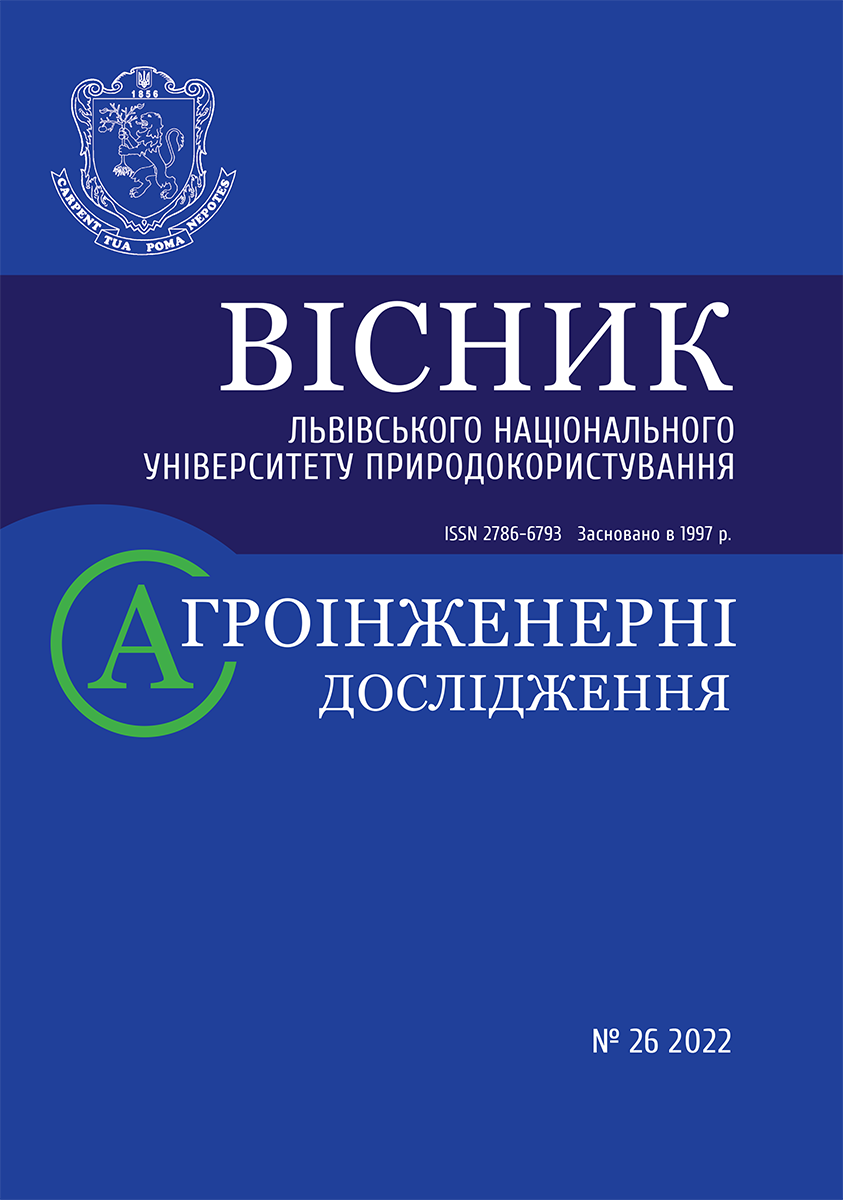Study of the physical and mechanical properties of walnuts
DOI:
https://doi.org/10.31734/agroengineering2022.26.005Keywords:
walnuts, physical and mechanical properties, size indices, fats, proteins, sugars, mass, length, thickness, width, energy of destructionAbstract
This article is devoted to studying the physical and mechanical properties of walnuts, which should be considered in their post-harvest treatment, because afterwards all nuts undergo mechanical actions, in particular destruction of shell, separation of kernel, cleaning, transporting, storage, processing, etc. Projecting and calculation of equipment for realization of mechanical operations are impossible without knowing the technological properties of constituents of fruit (shells, kernels). The effort of nut shell destruction should be known to set the optimal and rational parameters of operating parts which perform the functions of shell destruction and kernel separation, as well as to design machines and vehicles of food industry. Values of the volume and mass coefficients make it possible to establish the ratio of the yield of the purified kernel to the total weight and volume nuts.
To fulfill the set tasks, a program of experimental studies was developed. It involved studying the physical and mechanical properties of such walnut varieties as Chernivetskyi and Bukovynskyi which are highly appreciated in European countries and are successfully cultivated in the western regions of Ukraine. The studied properties included indices characterizing mass and size; mass coefficient; volume coefficient; work spent for shell destruction.
In the course of the research, the obtained results confirm that the range of fluctuations of the values for the dimensional indicators of walnut is insignificant, and the value of the variation coefficient does not exceed 10%. Therefore, in the process of designing some sorting and calibrating machines, there will be no significant problems when separating walnut kernels. The studied varieties give a significant output of products of the highest (50%) and first (45%) varieties, which corresponds to the mass coefficients µmax=0.5 and µsr=0.45, respectively.
The nut of these varieties can be classified as medium-walled with a shell thickness of 1.11–1.3 mm, and the value of the work spent for its destruction must be taken into account when designing crushing machines.
References
Bozhok, O. P., & Bozhok, V. O. (2017). Pro perspektyvy vyroshchuvannia horikha hretskoho na terytorii Ukrainy. Naukovyi visnyk NLTU Ukrainy, 27 (3), 25-29.
Buriak, V., & Pakhno, V. 2014. Suchasnyi stan ta perspektyvy vyrobnytstva y spozhyvannia horikhiv v Ukraini. Sad, vynohrad i vyno Ukrainy, 1/3, 16-19.
Volkov, V., & Volkova, N. (2013).Chto skrыvaet skorlupa. Ohorodnyk, 1, 20-21.
Hoshko, Z. O., Krupych, O. M., & Krupych, R. O. (2017). Doslidzhennia fizyko-mekhanichnykh vlastyvostei plodiv lisovykh horikhiv. Visnyk Lvivskoho natsionalnoho ahrarnoho universytetu. Ahroinzhenerni doslidzhennia, 21, 30-37.
Hoshko, Z. O., & Mahats, M. Y. (2019). Yssledovanye fyzyko-mekhanycheskykh svoistv plodov funduka. In Novыe materyalы, oborudovanye y tekhnolohyy v promыshlennosty: Mezhdunar. nauch.-tekhn. konf. (h. Mohylev, 24–25 okt. 2019 h.) (p. 49). Mohylev.
Orlova, O. (2014). Yspolzovanye hretskoho orekha molochno-voskovoi spelosty dlia razrabotky funktsyonalnыkh produktov pytanyia. Protsessы y apparatы pyshchevыkh proyzvodstv, 1, 60-69.
Polievoda, Yu. A. (2019). Osoblyvosti realizatsii protsesu lushchennia shkaralupy horikha mizh plastynoiu ta sferychnoiu vstavkoiu. Vibratsii v tekhnitsi ta tekhnolohiiakh, 4 (95), 69-75.
Polievoda, Yu. A. (2019). Doslidzhennia protsesu lushchennia voloskykh horikhiv mizh dvoma paralelnymy plastynamy. Vibratsii v tekhnitsi ta tekhnolohiiakh, 3 (94),110-117.
Polievoda, Yu. A. (2020). Doslidzhennia protsesu skoliuvannia shkaralupy horikhiv v rezultati sylovoi dii napivsferychnykh poverkhon. Vibratsii v tekhnitsi ta tekhnolohiiakh, 3 (98), 111-119.
Lytvyn, B. Ya., Stadnytska, N. Ye., Konechna, R. T., & Krvavych, A. S. (2011). Predstavnyky rodu Juglans yak dzherelo oderzhannia biolohichno aktyvnykh rechovyn. Visnyk Natsionalnoho universytetu «Lvivska politekhnika», 700, 117-120.
Satina, H. M. (2005). Potentsial promyslovoho vyrobnytstva hretskykh horikhiv v Ukraini ta shliakhy yoho efektyvnoho vykorystannia. (Avtoref. dys. … kand. ekon. nauk). Kyiv.
Satina, H. M. (2004). Formuvannia vnutrishnoho i zovnishnoho rynku voloskykh horikhiv. Іn Materialy shostykh richnykh zboriv Vseukrainskoho konhresu vchenykh ekonomistiv-ahrarnykiv (pp. 299-303). Kyiv: NNTs IAES.
Statystychnyi shchorichnyk Ukrainy za 2016 rik. (2017). Kyiv: Znannia.
Strela, T. E. Orekh hretskyi. (1990). Kyev: Nauk. dumka.
Krupych, O. M., Levko, S. I., & Krupych, R. O. (2014). Sposib vyznachennia obiemu til nepravylnoi formy. In Vcheni Lvivskoho natsionalnoho ahrarnoho universytetu vyrobnytstvu: Kataloh innovatsiinykh rozrobok,14, 63.
Lytovchenko, O. M., Pavliuk, V. V., & Omelchenko, I. K. (2011). Krashchi sorty plodovykh i horikhoplidnykh kultur ukrainskoi selektsii. Kyiv: Presa Ukrainy.
Shestopal, O. M., & Satina, H. M. (2002). Pryrodno-ekonomichni peredumovy promyslovoho vyroshchuvannia horikha hretskoho v Ukraini. Zbirnyk naukovykh prats Luhanskoho derzhavnoho ahrarnoho universytetu, 14 (26), 392-396.
Shchepotiev, F. L., Pavlenko, F. A., & Rikhter, O. A. (1987). Horikhy. 2-he vyd., pererob. i dopov. Kyiv: Urozhai.


